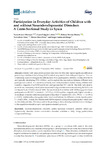Participation in everyday activities of children with and without neurodevelopmental disorders: a cross-sectional study in Spain

Use este enlace para citar
http://hdl.handle.net/2183/26768
A non ser que se indique outra cousa, a licenza do ítem descríbese como Creative Commons Attribution 4.0 International License (CC-BY 4.0)
Coleccións
- Investigación (FCS) [1295]
Metadatos
Mostrar o rexistro completo do ítemTítulo
Participation in everyday activities of children with and without neurodevelopmental disorders: a cross-sectional study in SpainAutor(es)
Data
2020-10-01Cita bibliográfica
Blanco-Martínez N, Delgado-Lobete L, Montes-Montes R, Ruiz-Pérez N, Ruiz-Pérez M, Santos-Del-Riego S. Participation in everyday activities of children with and without neurodevelopmental disorders: a cross-sectional study in Spain. Children (Basel). 2020 Oct 1;7(10):157.
Resumo
[Abstract]
Children with neurodevelopmental disorders (NDDs) often report significant difficulties performing activities of daily living (ADLs), which may restrict their daily participation. The aim of this study was to investigate the differences in ADLs participation between children with NDDs and typically developing (TD) children, and to explore the associations between different daily participation contexts. A cross-sectional study was conducted that included twenty children with a medical diagnosis of an NDD and 26 sex- and age-matched TD controls. The daily participation across home, community, school, and instrumental living activities was measured using the Child and Adolescent Scale of Participation (CASP). The results show that children with NDDs engaged in lower participation in all CASP contexts (Δ = 1.7–5.5, p < 0.001) and had a significantly higher prevalence of moderate or severe restricted participation than their TD peers (OR = 23.4, 95% CI = 3.6–154.2, p < 0.001). Additionally, a strong association was found between the different contexts of participation (r = 0.642–0.856). Overall, the children with NDDs experienced significant participation restrictions on their daily activities. This study adds to the growing evidence showing that intervention strategies in this population should adopt a participation-oriented approach.
Palabras chave
Neurodevelopmental disorders
Autism spectrum disorder
Attention deficit and hyperactivity disorder
Motor coordination disorder
Activities of daily living
Participation
Occupational therapy
Autism spectrum disorder
Attention deficit and hyperactivity disorder
Motor coordination disorder
Activities of daily living
Participation
Occupational therapy
Versión do editor
Dereitos
Creative Commons Attribution 4.0 International License (CC-BY 4.0)
ISSN
2227-9067
Ítems relacionados
Mostrando ítems relacionados por Título, autor ou materia.
-
Capacity of the CCC-2 to Discriminate ASD from Other Neurodevelopmental Disorders
Durán-Bouza, Montserrat; Pérez-Pereira, Miguel; De la Torre Carril, Alba (2021)[Abstract] The Children’s Communication Checklist (CCC-2) has demonstrated its usefulness as an instrument to assess discrepancies between the use of structural dimensions of language and the pragmatic and sociointeractive ... -
Sensory processing patterns in developmental coordination disorder, attention deficit hyperactivity disorder and typical development
Delgado-Lobete, Laura; Pértega-Díaz, Sonia; Santos-del-Riego, Sergio; Montes-Montes, Rebeca (Elsevier, 2020-02-19)[Abstract] Background. Sensory processing difficulties (SPD) are present in children with Developmental Coordination Disorder (DCD) and Attention Deficit and Hyperactivity Disorder (ADHD). However, little is known about ... -
Validity and reliability of the spanish version of the Somatoform Dissociation Questionnaire (SDQ-20)
González-Vázquez, Ana Isabel; del Río-Casanova, Lucía; Seijo-Ameneiros, Natalia; Cabaleiro-Fernández, Paloma; Seoane-Pillado, Teresa; Justo-Alonso, Ania; Santed-Germán, Ángel (Colegio Oficial de Psicología del Principado de Asturias, 2017)[Abstract] Background: The Somatoform Dissociation Questionnaire (SDQ-20) is a self-reported questionnaire measuring somatoform dissociation. The aim of this study is to analyze the psychometric properties of the Spanish ...






